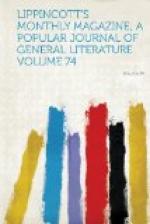Hearing persons who understand the sign-language sometimes find it exceedingly convenient as a means of communicating when they wish to be private, I remember an amusing incident occurring at a festival which I attended while teaching in the Illinois institution. Another teacher and myself sat apart, surrounded by entire strangers. Near by stood a lady in a gorgeous green silk dress, with many gaudy accessories. My companion remarked in signs to me upon her striking costume. I replied in like manner, expressing my appreciation of so magnificent a proportion of apple-green silk. There was a great deal of lady, but a great deal more of dress.
“See them dummies, Jake,” she remarked to her husband at her side, whose dazzling expanse of bright-figured velvet waistcoat and massive gold chain was in admirable keeping with his wife’s attire. It was a landscape, begging the word, after Turner’s own heart. “Them’s two dummies from the asylum, I know,” she continued. “Let’s watch ’em make signs.” And she gazed upon us from the serene heights of green sward with an amused, patronizing smile.
We dared not laugh. Dummies we had been dubbed, and dummies we must remain to the end of the scene. Were ever mortals in such a fix? We talked them over well, however, while suffering tortures from our pent-up emotions.
“That there one’s rayther good-looking,” ventured the proprietor of the velvet and gold.
“Not so mighty, either,” said his wife, bridling. “Face is too chalky-like, and the other one is too fat.” This was near being the death of us both, as the two critics together would have turned the scale at near five hundred. Consternation seized us just then, however, as we saw a fellow-teacher approaching us who would be sure to address us in spoken language and reveal us as two cheats. Hastily retreating from the scene, we made our way to an anteroom, where it was not considered a sin to laugh.




